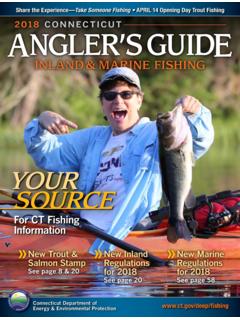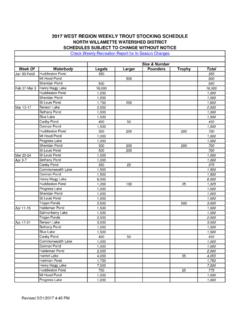Transcription of John Kingdon’s “Three Streams” Theory and the ...
1 25 John kingdon s Three Streams Theory and the Antiterrorism and Effective Death Penalty Act of 1996 Paul J. Larkin, Jr. Book reviews strive to analyze new publications that advance the intellectual development of an old or new idea. Their purpose is to see whether the author s proposal accurately captures the current state of knowledge or suggests a new direction for policy or legal theories already in play. To serve that purpose, book reviews by and large try to follow closely on the heels of the publication date of a new book. Books published five or ten years ago, let alone twenty-five years ago, are, to use the vernacular, so twenty minutes ago that they generally are not worth reviewing.
2 Over a twenty-year period, the policy and legal discussions in a book either have become positive law in some form ( , a statute, a regulation, an official government policy statement, etc.) and therefore have a history to be assessed, or they have been evaluated and found wanting intellectually or unworkable practically. Every now and then, however, it makes sense to consider whether an author s idea is still valuable long after that author first penned his proposal. That course is particularly helpful when an author proposes a method for analyzing the structural process of policy or legal decision making, rather than a new substantive idea. For example, law schools today generally offer a class devoted to statutory analysis as a supplement to the common law, case-by-case decision making process that first-year law students learn in courses on torts, contracts, and property.
3 The impetus for such a change in the law school curriculum likely is due to the recognition that, from the New Deal to the present, legislatures make policy judgments more often than Paul J. Larkin, Jr., 1977 Washington & Lee University; 1980 Stanford Law School; 2010 George Washington University; Senior Legal Fellow, the Heritage Foundation. The views expressed in this article are my own and should not be construed as representing any official position of The Heritage Foundation. 1 That is not to say that courts do not make policy judgments, even if only from molar to molecular motions. S. Pac. Co. v. Jensen, 244 205, 221 (1917) (Holmes, J.)
4 , dissenting). They do. But it is one thing for a court to enjoin the government to comply with the Constitution in how it administers a federal program, such as Social Security, Medicare, or Medicaid, see, , Califano v. Goldfarb, 430 199 (1977) (holding Social Security Act benefits cannot be apportioned on the basis of sex), and another thing altogether for a court itself to create its own initiative along those lines. Federal courts are reluctant to supervise the operation of existing institutions, see Rizzo v. Goode, 423 362 (1976), let alone start from scratch to create one out of whole cloth. 26 Journal of Law and Politics [ :25 A publication that critiques this combined case law and statutory analysis approach to legal decision making and teaching could prove valuable long after its recommendations have been adopted or allowed to die a slow death on a bookshelf the fate of most policy reports.]
5 Such a work could prove valuable because it makes sense to ask whether a new way of viewing a subject continues to resonate long after the book is first published. Once in a while, then, it is valuable to see a book reconsideration perform that job, a job that a book review cannot, precisely because a book review lacks the sense of history necessary to perform a long-term critique of a publication. In his 1984 book Agendas, Alternatives, and Public Policies,2 Professor John kingdon came up with a new approach to the analysis of public policy decision He developed the Theory that the timely confluence of three streams the problem stream, the policy stream, and the political stream is what creates the momentum necessary to place an issue on the public policy agenda, to move it from the government agenda (or under discussion ) box to the decision agenda box, and to lead government finally to change public policy.
6 While it is potentially relevant to the policy decisions of each agency of federal or state government, kingdon s Theory supplies an especially useful prism for analysis of the political branches of the federal government. The tremendous expansion in the twentieth century of the federal government s authority leaves virtually no aspect of contemporary public policy beyond its reach; Congress, at least, legislates as if no such limit Congress 2 JOHN W. kingdon , AGENDAS, ALTERNATIVES, AND PUBLIC POLICIES (1984). kingdon published a second edition in 1995. See JOHN W. kingdon , AGENDAS, ALTERNATIVES, AND PUBLIC POLICIES (2d ed. 1995) [hereinafter kingdon ].
7 The second edition adds a new chapter (10) containing kingdon s reflections on public policy events and thinking since the publication of his 1984 book, but he kept the body of the book exactly the same as it was in the first edition. kingdon , supra, xiii. For the reader s convenience, I will use the second edition as the template. 3 For a panoramic but concise description of the different public policy decision making theories, see JAMES E. ANDERSON, PUBLIC POLICYMAKING (7th ed. 2010). 4 In the Gun-Free School Zones Act of 1990, Congress made it a federal offense for a person knowingly to possess a firearm in the vicinity of a school. See 18 922(q)(1)(A) (1988 ed. & Supp. V). The statute did not require that the government prove that the act of possession was in or affected interstate commerce, or that the firearm had travelled in interstate commerce.
8 The Supreme Court concluded that Congress had gone too far. See United States v. Lopez, 514 549 (1995) (holding the act unconstitutional as exceeding Congress commerce power). Recently, the Court has held that there are other material limits as to how far the Congress can reach, under the Commerce Clause, CONST. art. I, 8, cl. 3, to regulate private activity. See United States v. Morrison, 529 598 (2000) (holding unconstitutional a statute making rape a federal crime). The Court revisited this issue in Nat l Fed n of Indep. Bus. v. Sebelius, 132 S. Ct. 2566 (2012), which involved the constitutionality of the Patient Protection and Affordable Care Act, Pub. L. No. 111-148, 124 Stat.
9 119 2012] Three Streams Theory 27 and the President also enjoy a far greater ability to create that agenda, and they are far more directly influenced in doing so by changing public sentiment than are the nonpolitical branches , the federal judiciary and the executive bureaucracy. Public policy analysts always can find something of interest in what the federal government already has done or has been asked to do. The work of Congress is a target-rich environment for that industry. I. kingdon S THREE STREAMS: PROBLEM, POLICY, AND POLITICS Agendas, Alternatives, and Public Policies starts out with this puzzle: In public policy debates, some discussions are premature, others have become moot or pass , and a few (let s call them the Goldilocks issues) arise at just the right time for discussion to lead to Practitioners, academics, and everyday people may know the issues that might come into the spotlight, the alternatives to a problem raised and answer chosen, and (at least in retrospect) how a chosen answer came to be.
10 Ideas rarely can be traced to the creative thought process of a single individual or group; more often than not, so-called new ideas merely are variations on already-known The President and members of Congress can offer items for the agenda, and they, along with White House staff, executive branch career personnel, congressional staff, the media, lobbyists, private organizations, and even members of the public, can supply other agenda items or alternative ways of accomplishing any such (2010). There was no majority opinion. Chief Justice Roberts and Justices Scalia, Kennedy, Thomas, and Alito concluded that Congress lacked authority under the Commerce Clause to adopt that law, Sebelius, 132 S.


